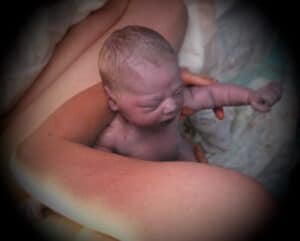December of 2001. Each Thursday night, I traveled to a liberal arts college to teach Institute to five undergraduate women. We were nearing the end of our study of the Gospels, and had returned to the Mount of Transfiguration. Jesus leads Peter, James and John to pray at the top of a mountain. There Jesus became transfigured, his face shining like the sun while a voice from Heaven proclaims, “This is my beloved son, in whom I am well pleased.” Neat stuff.
One woman – Relief Society president in a student ward – turned to me and said with a mixture of exasperation and dismay: “Why is it that men are around for all the good stuff? Where are the women?”
I was taken aback – I knew that women played a vital role in the four Gospels. Yet here it was – December – we were almost through with the course, and I had failed to help at least this student find herself reflected in the text. I began to answer her, but realized the question needed more than an evening. And so I proposed that we start again in January. All over again. Some weeks we didn’t cover more than a chapter, but we got to know these women – and in learning about them, I felt as if I finally understood why women were drawn to Christ and what he had to offer me 2000 years later.
We began with the first verses of Matthew. It’s Jesus’ family tree. The begets and begats that we tend to gloss over. Tucked inside the list of 40 men are four women – his mother, Mary, and three of his grandmothers: Tamar, Ruth, and Bathsheba. These women represent great faith and affliction. Three were widows. Ruth was in an interfaith marriage; her subsequent conversion causes her to leave the land she knows and love for a land of strangers. She struggles to support her family. Bathsheba is the victim of King David’s abuse of power; a heartbreaking story with too many modern parallels. Mary, of course, is chosen to be the Mother of Jesus – and yet she must tell Joseph news of her pregnancy before an angel appears to him to confirm it. Much like Joseph Smith, she is a teenager with a vision who must hope and pray that somebody believes her. These women do not have tidy stories, but their courage is central to Jesus’ maternal family history.
In the second chapter of Luke, two women prophesy of Christ: Elisabeth (whose friendship helps sustain Mary) and Anna who recognizes the baby Jesus in the temple and testifies of him “to all them that looked for redemption in Jerusalem.”
As the semester progressed, Luke and John especially came alive with stories of women, their friendship with the Savior, their honest questions, their humble hopes, their tearful entreaties. I did not have to hunt – chapter after chapter, there they were.
Let’s take Luke 7: 36 – 50
Now one of the Pharisees invited Jesus to have dinner with him, so he went to the Pharisee’s house and reclined at the table. When a woman who had lived a sinful life in that town learned that Jesus was eating at the Pharisee’s house, she brought an alabaster jar of perfume, and as she stood behind him at his feet weeping, she began to wet his feet with her tears. Then she wiped them with her hair, kissed them and poured perfume on them. When the Pharisee who had invited him saw this, he said to himself, “If this man were a prophet, he would know who is touching him and what kind of woman she is—that she is a sinner.”
Jesus answered him, “Simon, I have something to tell you.”
“Tell me, teacher,” he said.
“Two men owed money to a certain moneylender. One owed him five hundred denarii, and the other fifty. Neither of them had the money to pay him back, so he canceled the debts of both. Now which of them will love him more?”
Simon replied, “I suppose the one who had the bigger debt canceled.”
“You have judged correctly,” Jesus said.
Then he turned toward the woman and said to Simon, “Do you see this woman? I came into your house. You did not give me any water for my feet, but she wet my feet with her tears and wiped them with her hair. You did not give me a kiss, but this woman, from the time I entered, has not stopped kissing my feet. You did not put oil on my head, but she has poured perfume on my feet. Therefore, I tell you, her many sins have been forgiven—for she loved much. But he who has been forgiven little loves little.
Do you SEE this woman? he asks.
Just before this passage, Jesus raises from the dead the only son of a widow “And when the Lord saw her, he had compassion on her and said unto her, weep not.” He saw her.
In chapter 8, he is attended to and ministered to by Mary Magdelene, Joanna, and Susanna. Later in the chapter, a woman with a chronic illness seeks out and touches the hem of his garment. The apostles don’t see her (a recurrent common theme, by the way) but Jesus feels her presence. “And when the woman saw that she was not hid, she came trembling and falling down before him . . . and he said unto her, “Daughter, be of good comfort; they faith hath made thee whole; go in peace” Immediately thereafter he raises a young woman from the dead, taking her hand and calling out her name.
In John 4, he finally announces his ministry. And to whom? A Samaritan. A woman. A divorced women at that. He speaks to her individually, tells her of living waters. She “perceives” he is a prophet and runs to the city to tell others to come see the Christ. But did others “see” her? When the disciples enter they “marveled that he talked with the woman: yet no man said, What seekest thou? Or, Why talkest thou with her?”
In John 8, a group of “scribes and Pharisees” perform perhaps the most repulsive act prior to the betrayal of Jesus. They grab a woman and bring her before him – not as a human being but as an object, a test. “They say unto him, Master, this woman was taken in adultery, in the very act.” Moses says she should be stoned. What do you say? And again, he sees past the world to the soul – and after he shames the men away, he speaks to her alone. “Neither do I condemn thee: go, and sin no more.”
We hear about the Savior’s friendship with Mary and Martha, teaching them individually at their home. Mary anoints his feet as a symbol of his death and again she is misunderstood by all but the Savior. And when he sees their grief at the death of their brother, we read simply, “Jesus wept.” Knowing that he would soon raise Lazarus, he nevertheless mourned with these women who mourned.
As Christ’s last deed before his death, he looks after the welfare of his mother. And it is Mary Magdelene keeping watch at the tomb when others have lost hope. Her Lord is missing, she knows not where to find him — but she does not leave her watch. And when he appears, he turns her Gethsemane into a Mount of Transfiguration: “Jesus said unto her, “Woman, Why weepest thou? She, supposing him to be the gardener, saith unto him, Sir, if thou have borne him hence, tell me where thou hast laid him, and I will take him away. Jesus saith unto her, Mary. She turned herself, and saith unto him, Rabboni; which is to say, Master.”
I did not know at the beginning of that semester that I would need these women. That same semester, I began dating this great guy who is now my husband. It was an interfaith romance, which had never been my intention but which was undeniably placed in my path. He’ll tell you there was as much angst as romance those first few months, especially as a couple of interactions with otherwise well-meaning saints made me wonder about my place in the church, where I would fit in. One Sunday afternoon, I left church in tears and found myself driving toward the Boston Temple. And as I wondered and prayed in the parking lot, I thought of the women in my institute class and the women we had studied together: they
did not let the judgments of men and women separate them from their God. Time and again God reaches out with a rich compassion, a knowing compassion, a personal compassion. Jesus, and the women he loves – both on the page and in the flesh — continue to teach me this.






6 Responses
Thank you for this wonderful post.
I appreciated this post—it reminded me of a time when I studied John daily with another woman. The lessons the spirit taught me still resonate.
Deborah, this is inspiring. You always impress me with your ability to see women, in the scriptures, in Mormon history, and around you.
Deborah, how beautiful.
This is why I love the New Testament so much.
One of my favorite passages in the New Testament regarding women: When Paul (Romans: 16:7) refers to a woman, Junia, as “outstanding among the apostles.”
I love that early Christian Church.
Thanks for the kind words. Jenny — the class was all-women by chance, but it was key to the magic of that particular semester.
[…] Exponent: Sacrament Talk: Do You See This Woman (by Deborah) 0 people like this post. […]